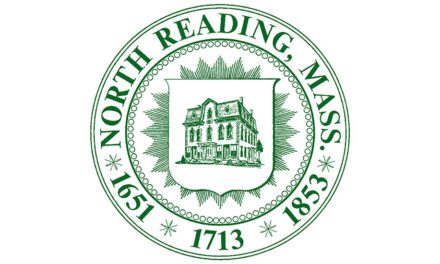Published in the November 9, 2017 edition
By MAUREEN DOHERTY
NORTH READING — Enforcement of the town’s snow removal bylaw will remain in limbo for a bit longer following an hour-long debate about the matter at Monday night’s Selectmen’s meeting.
Originally passed by the town’s voters back in 2002 as a means to force commercial property owners in the town’s business corridor to remove snow from the constructed sidewalks along their frontage, it was amended by the voters last June to enable the town to recoup snow removal costs through a betterment process when businesses have not removed the snow themselves.
This angle was taken after it was determined that having the police issues “tickets” to businesses that did not remove the snow was not a good use of the town’s resources as the fines were typically dismissed when appealed.
After the AG’s office approved the bylaw, Town Administrator Michael Gilleberto and DPW Director Andrew Lafferty attempted to come up with a method to assess the cost, which has proven to be quite difficult due to the number of variables related to each storm. The cost was staggering and surprised the board members.
One cost breakdown for a very large storm of 20-plus inches raised the eyebrows of Selectmen totaling an estimated $151,543, or $1,515 assessed for the average Rte. 28 property owner with 179-feet of frontage. When this figure was presented last month, Selectman Andrew Schultz asked how the town could present such a high bill to a property owner “with a straight face” while Selectman Steve O’Leary commented that was close to the cost of snow removal for the entire town.
Gilleberto was looking for the board’s endorsement Monday night of the process they came up with so that the business community could be informed of the changes before the snow flies.
However, the board had been perplexed by the silence from the business community on the issue going back to June Town Meeting as Selectmen Chairman Michael Prisco noted no business owners had come forward to offer their opinion about it either during public hearings or at Town Meeting.
That all changed Monday night when about a dozen business owners attended the meeting and all opposed the proposal as unfeasible and uneconomical.
Ultimately, the Selectmen agreed with the business owners and chose not to endorse the betterment assessment proposal at this time.
Business owner David O’Neil, 9 Heritage Way, said he does believe the sidewalks should be plowed but the onus should not be put on the business owners. He recommended that the town employ one person in a Bobcat “to go up and down Main Street.”
Jack Hashem said his company owns “half a dozen” properties along Main Street, including the Heritage Building at 133-135 Main Street and the medical building at 203 Main St., both of which have sidewalks along their frontage, but the adjacent business properties do not. In this situation, keeping his sidewalks clear seems pointless when the pedestrian would not be able to continue walking down Rte. 28 without entering the street.
Having the state plow all the snow and ice off the 50-foot right of way and then having the town tell the local business owners “to deal with it” did not seem fair to Hashem either.
“We don’t have sidewalk plows. I don’t feel that it is the burden of the property owners to have to deal with 50 feet of snow and slush… and the liability that goes a lot with it,” Hashem said. “I don’t think it is a good idea to promote walking on Main Street until the road is finished with proper sidewalks that can be plowed. There is no where to put it,” he said, adding many of these properties along Rte. 28 are only 10,000 to 20,000 square foot lots.”
Matt Donnelly, a resident of Reading, who owns Merry Maids on Rte. 28 said he pays both property and excise taxes to the town as his fleet has grown from one car to 20 over the years. He said the issue is that the state plows ice and slush from “a four-lane highway onto the sidewalks. I can’t understand why the town would put the burden onto business owners,” especially given the different leases in place.
Pat Lee of 22 Aspen Rd. and owner of the Horseshoe Grille, asked, “Who decides what is clear, suitable” for a sidewalk?
Gilleberto said it would likely fall to the DPW foreman or DPW director. Lafferty said it has been done in conjunction with the Police Department, plus his opinion and the general foreman’s observation. As a general rule, Lafferty said a sidewalk is “deemed unsafe” if the obstruction from snow and ice “causes a person to walk into the road.”
Lee said it sounds like a “very gray” area when facing a possible assessment “in four figures.” The estimated cost provided by the DPW at their meeting last month was based on linear feet of sidewalk for the cost of removing the snow and trucking it off-site following a 20-inch storm. Factoring in overtime, administrative costs and possible police details, it would cost about $1,500 for an average business with about 180 feet of frontage. Lee said he has 200 feet of frontage.
Lafferty said there would be a range of costs “to cover any variety of storms,” adding, “Our personnel will determine the level of effort it cost to remove the snow.”
The bylaw gives businesses 24 hours snow the storm has ended to remove the snow.
O’Neil posed a question to the board: “Does the vote at Town Meeting say that the town cannot clear the snow? No, it doesn’t. The town can authorize Public Works to take care of it. And I think that is what the business community is asking for. Look at this room. These are the people that support this community. Every single person here is the one that supports every single fundraiser that comes down the pike. I have been in business close to 40 years in this community and I have bought tickets to everything that has come down the pike. And this is way you are now going to play nickel and dime with people? There is no reason that this board cannot say to Public Works figure it out, take care of it.”
Selectman Bob Mauceri pointed out that even in the areas of town near the schools where the town plows the sidewalks the condition of the sidewalks can vary widely. “Sometimes they’re down to the ground and sometimes it’s a pile of ice and sometimes you can’t get through because there is a pole,” he said.
For businesses along Rte. 28, they have all of those factors to deal with plus the matter of the state plows redepositing the snow and ice from the four-lane road back onto the sidewalks. These sidewalks are “never perfectly safe to walk on (and) it is beyond what we can afford,” Mauceri said.
Mauceri also lamented the number of hours spent trying to address “an almost impossible situation to deal with.”
“We got a group of businesses that meet regularly. They have a (chamber) president. I would like to hear what, as a group, you could come up as a proposal that will get a job done and meet the bylaw. Then, round up enough citizens in town, make up a citizens’ petition to modify the bylaw. Personally, on Rte. 28, I am not walking anywhere near there. I am going to drive my car from one business to another.”
O’Leary added, “It doesn’t appear as though we can have a practical application without causing unnecessary, undue harm to the business owners and property owners.”
Regarding Mauceri’s suggestion that the business community get together and come up with solutions, O’Leary said, “I know exactly what it is going to be: ‘We pay our taxes,’ as Mr. O’Neil pointed out, ‘send a sidewalk plow down.’”
O’Leary said that under the current practice of attempting to fine business owners who do not comply, “it doesn’t even cover our costs.”
“I have lived in town my whole life. While there are people who walk Rte. 28, they’re few and far between” especially “in the middle of winter,” O’Leary said. “While the convenience and safety of those people is important, it has to be practical. We can’t afford, as a community, to do it and do it well. The business owners cannot afford to do it and do it well either. If that is the case let’s recognize it and come up with another solution or acknowledged the fact that it can’t be done.”
He added the cost estimate for the betterment assessments provided by Lafferty at the last meeting further drove home that point that the cost to attempt to clear this snow from the sidewalks on Rte. 28 was about equal to the cost of clearing the snow from the entire town.
Chairman Prisco agreed, adding, “We did not see the full impact until now. We did not have these figures in June.”
However, Prisco also pointed out that it was the townspeople, not the Board of Selectmen, who have been pushing this matter and their desire to have a “walkable” Rte. 28.
Lee said it could potentially more worthwhile to pay the fine rather than open himself up to a liability.
Selectman Kathryn Manupelli noted that the fine is not $300 per storm, it is is $300 every 24-hour period after the storm that the snow is not removed.
Selectman Andrew Schultz has said he opposes the bylaw. He is both a homeowner and a business owner on Main Street. He made a motion for the board to pass over the request to finalize this betterment proposal and “work with the business community to craft a better solution.” Schultz is the liaison to the business community from the board.



